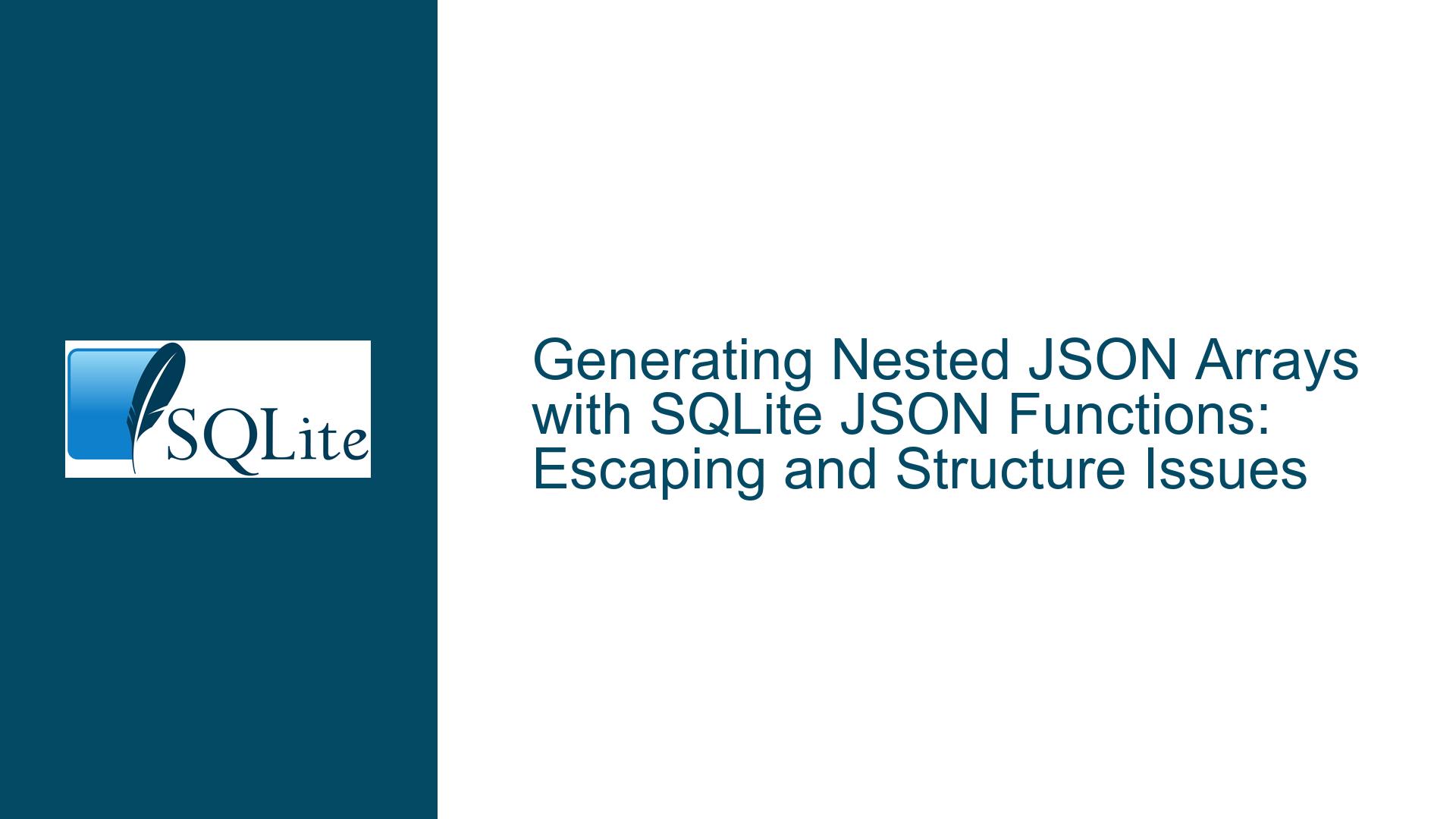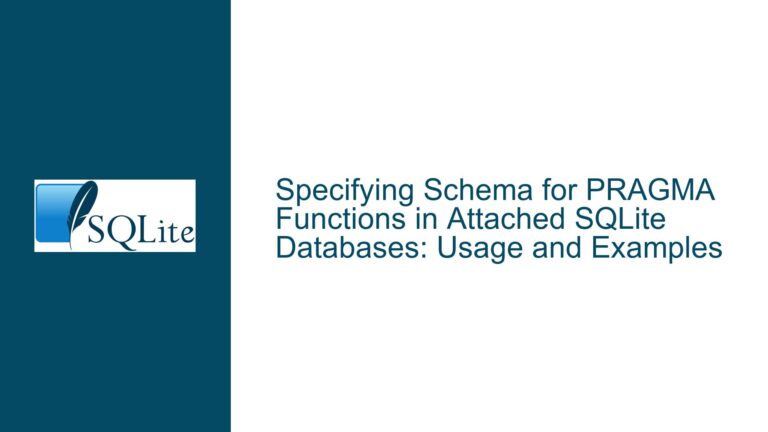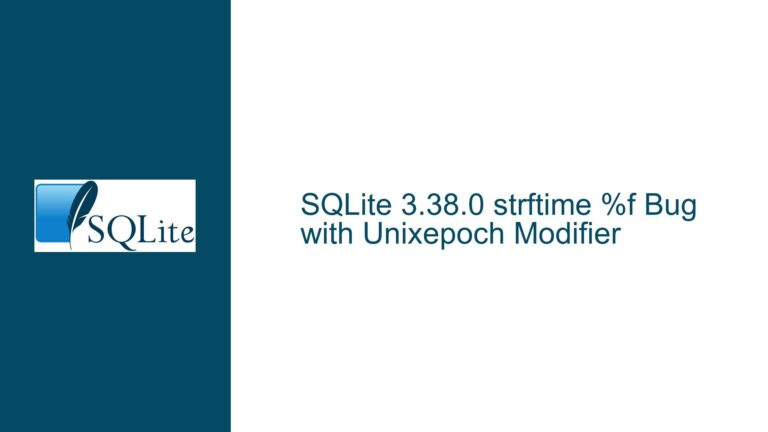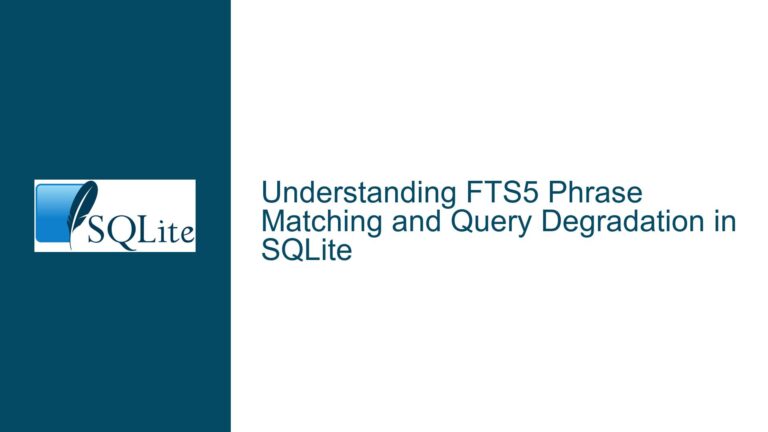Generating Nested JSON Arrays with SQLite JSON Functions: Escaping and Structure Issues
Issue Overview: Struggling to Build Hierarchical JSON with Proper Nesting and Escaped Characters
The core challenge revolves around transforming tabular data into a nested JSON array structure using SQLite’s JSON functions. The input data consists of menu items grouped by menu_id, each containing multiple commands ordered by command_order. The desired JSON output requires two levels of nesting:
- Top-Level Menu Objects: Each object key is
menu_label, with its value being an array of command objects. These top-level objects must be ordered bymenu_order. - Command Arrays: Within each menu object, commands must appear as an array of objects with
labelas the key andcommandas the value, ordered bycommand_order.
The initial attempt to construct this JSON resulted in improperly escaped strings (e.g., "[{\"New\":\"do_new\"}]") instead of valid nested JSON arrays. This occurs because intermediate JSON fragments lose their "JSON subtype" during aggregation, causing SQLite to treat them as plain text strings. The solution involves explicitly casting these fragments back to JSON using the json() function to preserve structure and prevent escaping.
Possible Causes: JSON Subtype Loss During Aggregation and Misordered Grouping
Three primary factors contribute to the issue of escaped JSON strings and incorrect nesting:
Intermediate JSON Subtype Loss:
When usingjson_group_array()orjson_object()in subqueries or CTEs, SQLite may fail to retain the JSON subtype of the generated fragments. This occurs because the JSON functions in SQLite dynamically allocate memory for JSON objects/arrays, and when these are stored in temporary tables (as in CTEs), they revert to their textual representation. Subsequent operations then treat them as strings, leading to escaped quotes.Insufficient Nesting of JSON Functions:
Failing to wrap aggregated JSON fragments withjson()after grouping operations forces SQLite to interpret them as string literals. For example,json_group_array(json_object(label, command))produces a valid JSON array, but when this array is inserted into another JSON object withoutjson(), it becomes a string:json_object(menu_label, x) -- x is a JSON array stored as textThis results in escaped characters.
Misordering During Grouping:
Incorrect use ofORDER BYclauses within aggregation steps can disrupt the hierarchical ordering required for menus and commands. Themenu_orderandcommand_ordercolumns dictate the sequence of top-level menus and their commands, respectively. If ordering is not enforced at both the command aggregation and menu aggregation stages, the final JSON will not reflect the intended structure.
Troubleshooting Steps, Solutions & Fixes: Preserving JSON Subtypes and Structuring Aggregations
Step 1: Validate Input Data Ordering
Before constructing JSON, ensure the raw data is ordered correctly. Use explicit ORDER BY clauses in CTEs to enforce the desired sequence for menus and commands:
WITH ordered_commands AS (
SELECT
menu_id,
menu_order,
menu_label,
command_order,
label,
command
FROM data
ORDER BY menu_order, command_order
)
This guarantees that menus appear in menu_order sequence, and commands within each menu follow command_order.
Step 2: Aggregate Commands into JSON Arrays
Group commands by menu_id, menu_order, and menu_label, converting each command into a JSON object and aggregating them into an array:
, aggregated_commands AS (
SELECT
menu_id,
menu_order,
menu_label,
json_group_array(
json_object(label, command)
) AS commands_json
FROM ordered_commands
GROUP BY menu_id, menu_order, menu_label
)
At this stage, commands_json contains valid JSON arrays like [{"New":"do_new"}, ...], but SQLite treats them as text.
Step 3: Recast JSON Strings to JSON Subtype
Apply json() to commands_json to restore the JSON subtype and prevent escaping when embedding it into outer JSON objects:
, recast_commands AS (
SELECT
menu_order,
menu_label,
json(commands_json) AS commands_json
FROM aggregated_commands
)
The json() function parses the textual JSON array and marks it as a JSON subtype, ensuring it is treated as structured data in subsequent operations.
Step 4: Assemble Top-Level Menu Objects
Construct the top-level menu objects by combining menu_label with the recast commands_json:
, menu_objects AS (
SELECT
json_object(
menu_label,
commands_json
) AS menu_json
FROM recast_commands
ORDER BY menu_order
)
Using json_object() here with the recast commands_json avoids escaping because both the key (menu_label) and value (commands_json) are valid JSON components.
Step 5: Aggregate Menu Objects into Final JSON Array
Use json_group_array() to combine all menu objects into a single JSON array, ensuring the final output maintains the correct order:
SELECT json_group_array(menu_json) AS final_json
FROM menu_objects;
This produces the desired output without escaped characters:
[
{ "File": [ {"New": "do_new" }, {"Open": "do_open" } ] },
{ "Edit": [ {"Copy": "do_copy"}, {"Paste": "do_paste" } ] }
]
Comprehensive Solution Query
Combining all steps into a single query:
WITH ordered_commands AS (
SELECT *
FROM data
ORDER BY menu_order, command_order
),
aggregated_commands AS (
SELECT
menu_id,
menu_order,
menu_label,
json_group_array(json_object(label, command)) AS commands_json
FROM ordered_commands
GROUP BY menu_id, menu_order, menu_label
),
recast_commands AS (
SELECT
menu_order,
menu_label,
json(commands_json) AS commands_json
FROM aggregated_commands
),
menu_objects AS (
SELECT
json_object(menu_label, commands_json) AS menu_json
FROM recast_commands
ORDER BY menu_order
)
SELECT json_group_array(menu_json) AS final_json
FROM menu_objects;
Key Fixes and Rationale
Explicit Ordering:
TheORDER BYclauses inordered_commandsandmenu_objectsensure that both menus and commands appear in the correct sequence. Without this, the aggregation functions might not respect the intended order, as SQLite does not guarantee row order without explicit directives.JSON Subtype Preservation:
Thejson()function inrecast_commandsis critical. It converts the textual JSON array produced byjson_group_array()into a recognized JSON subtype. This prevents SQLite from escaping the JSON when it is embedded into another JSON object.Layered Aggregation:
By breaking the problem into CTEs—ordering, command aggregation, JSON recasting, and menu object creation—the query maintains clarity and ensures each transformation step is validated before proceeding.
Debugging Escaped JSON Issues
If the final JSON still contains escaped strings, inspect intermediate results using SELECT statements in CTEs:
-- Check output of aggregated_commands
SELECT * FROM aggregated_commands;
-- Verify commands_json is a valid JSON array string
-- Check output of recast_commands
SELECT typeof(commands_json) FROM recast_commands;
-- Should return 'json'
If typeof(commands_json) returns text, the json() function was not applied correctly.
Alternative Approach: Direct Nesting Without CTEs
For simpler cases, the query can be condensed by nesting functions directly, though this sacrifices readability:
SELECT json_group_array(
json_object(
menu_label,
json(
(SELECT json_group_array(json_object(label, command))
FROM data AS d2
WHERE d2.menu_id = d1.menu_id
ORDER BY command_order)
)
)
) AS final_json
FROM (SELECT DISTINCT menu_id, menu_order, menu_label FROM data) AS d1
ORDER BY menu_order;
This uses a correlated subquery to aggregate commands per menu, but it may incur performance overhead with large datasets.
Performance Considerations
- Indexing: Add indexes on
menu_order,menu_id, andcommand_orderto speed up ordering and grouping:CREATE INDEX idx_data_menu ON data(menu_order, menu_id); CREATE INDEX idx_data_command ON data(menu_id, command_order); - Materialized CTEs: SQLite materializes CTEs by default, which can buffer intermediate results and improve performance.
Conclusion
The solution hinges on understanding how SQLite manages JSON subtypes during aggregation and the necessity of explicit recasting. By enforcing order at each stage and using json() to preserve JSON structure, developers can generate complex nested JSON outputs directly from SQL queries, avoiding escaped strings and ensuring valid syntax.






